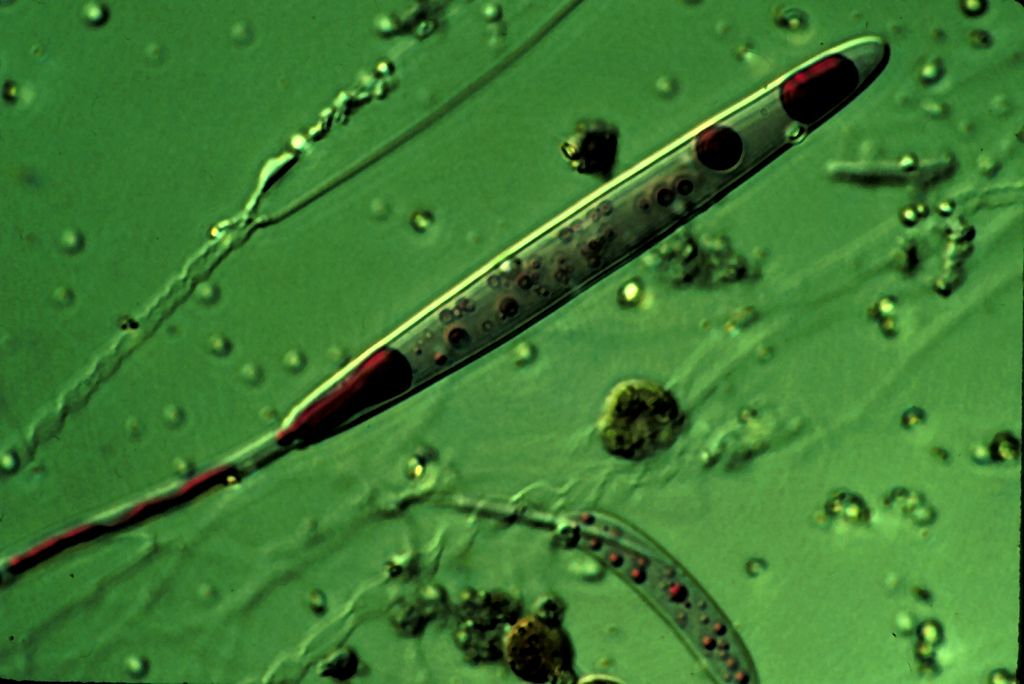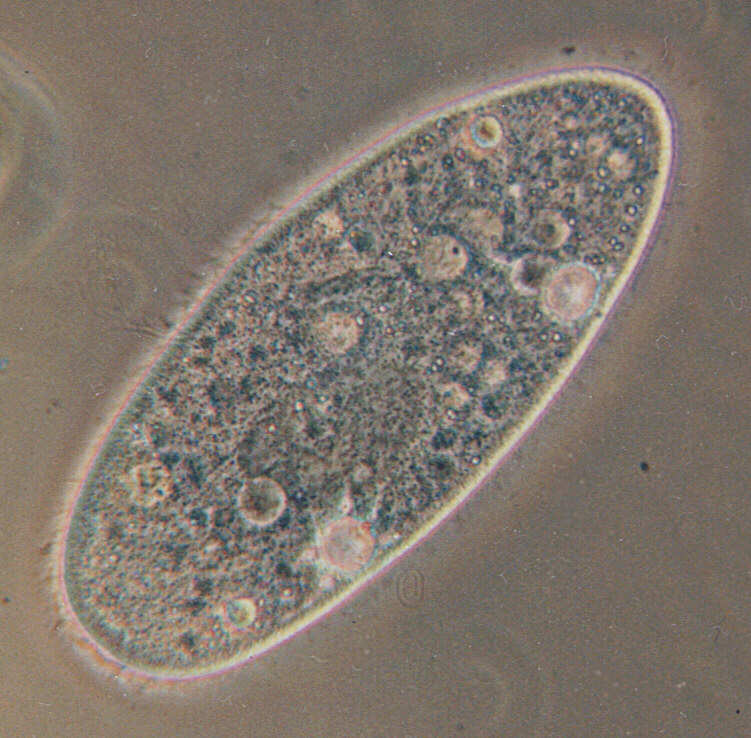Copyright
2016 by Gary L. Pullman
We
know what lions and tigers and bears use to defend themselves. We
know, too, that there are many other forms of animal defense besides
teeth and claws. There are beaks, talons, foul-smelling odors,
quills, venom, hooves, stingers, camouflage, mimicry, and even
playing dead.
There
are a few unconventional and downright bizarre animal defenses, too,
spitting, spurting blood, oozing cyanide, vomiting (yuck!), and
squirting “ink,” among them.
But
what about organisms that are too small to grow teeth and claws, or
don't have blood and can't vomit on themselves? What do they do to
fend off predators?
Can
one-celled organisms defend themselves at all?
The
microscopic world is every bit as brutal and pitiless as the larger
world we inhabit. There are many threats and predators. Are
unicellular organisms destined to be nothing more than some other,
bigger organism's next meal?
Fortunately
for them, the answer is no. Most are capable of defending themselves.
In fact, several one-celled organisms use more than one form of
defense.
These
are 10 of the amazing defenses of one-celled organisms.
10
Trichocysts
Basically,
a trichocyst is a harpoon.
Certain
one-celled animals, such as the paramecium, can launch this weapon
when they are threatened. Some of these organisms are equipped with a
whole arsenal of trichocysts,
“widely distributed” over the outside of the entire cell. Others
have only several that are “restricted to certain areas” of their
outer cells.
There
are three types of trichocysts: mucoid, filamentous, and toxic.
Mucoidtrichocysts
are long, and they can be seen as they launch. Filamentous
trichocysts look like threads and have rod-like tips at their ends.
Toxicysts, which are restricted to the mouth area, resemble tipped
threads, too, but, unlike ordinary filamentous
trichocysts, they can be used offensively as well as
defensively, to paralyze
or kill predators or prey.
For
some unicellular organisms, this weapon has another use, too. The
paramecium uses its filamentous trichocysts to anchor
itself to one spot while it feeds.
Dinoflaggelates
are also armed with trichocysts—and with two similar weapons,
nematocysts
and mucocysts. (In addition, as we have seen,
dinoflaggelates can light
up the night to discourage predators.)
9
Nematocysts
Nematocyst
If
the trichocyst is like a harpoon, a nematocyst is a like a missile or
a bomb.
It's
a tiny, long or round “capsule” loaded with a poisonous
thread. The thread is “coiled, hollow, [and] usually barbed.”
When a one-celled organism, such as a dinoflaggelate, is attacked or
otherwise properly “stimulated,” the thread “quickly turns
outward” from the capsule, so that the launched thread can fend off
predators or ensnaring prey.
The
barbs “act
like a drill, penetrating into” the predator. In the process, the
thread is pulled into the attacker. The toxin passes through the
hollow thread, paralyzing the victim. Then, the thread detaches from
the nematocyst.
8
Mucocysts
A
mucocyst is like a flame-thrower, except it throws something other
than fire.
“Small
sac-like
organelles,” mucocysts contain a mucus-like substance that it
“discharges” when an organism, such as the Tetrahymena
pyriformis,
is
attacked or otherwise provoked. The mucus-like stuff forms
a “protective
covering” around the organism.
7
Spines
Rotifer
Rotifers'
weapons are spines. Some predators release chemicals called
kairomones that stimulate the rotifers' spines to lengthen. This
modification is an example of “predator-induced
morphologicaldefense.” This ability comes in handy among
rotifers, because larger
specimens often eat smaller ones. The elongation of the
rotifer's spines prevent them from being ingested by larger rotifers,
because the longer spines “either cannot enter the pharynx through
the mouth or cannot be” swallowed and are, therefore, “maneuvered
from
the pharynx into the esophagus andstomach and are rejected.” In the case of some rotifers, the changed length of the
spines last from before the rotifer's birth and continue throughout
its lifespan. In other rotifers, this induced change
in spine length can occur after the rotifer is born and disappear
before its death.
Although
rotifer spines lengthen in response to predators' kairomones, they
also elongate
when temperatures are low or food is scarce. Although some scientists
speculate that “predator-induced morphological defense” may have
a trade-off, costing the organism something, such as a lower
reproductive rate, the results of research have been inconsistent and
the issue has not been resolved.
6
Armor
Not
only are dinoflaggelates armed with trichocysts, nematocysts, and
mucocysts, but they are also capable of bioluminescence. And that's
not all.

Dinoflaggelate
Dinoflaggelates
are also armored! Their hard coating, the theca,
protects them against predators.
The
armor consists of “two major. . . regions composed of 100
individual
plates” of cellulose, which form both an anterior, or
frontal, horn and “usually two posterior,” or rear, horns.The plates' edges “overlap, sliding apart as the cell
increases in size” to permit the cell's expansion.
The
spines adapt
to their environment. When they are in “cold, salty water,” the
spines are “shorter and thicker.” In “less salty, warmer
water,” the spines are “longer and thinner.”
Any
microorganism that wants to take on a dinoflaggelate had better be
determined. It will have to be to get past this guy's arsenal!
While
it is not exactly armored, the paramecium does “ have a pellicle
with alveoli that helps to provide stiffness. In addition, it defends
itself with its trichocysts.
5
Flight and Evacuation
Some
one-celled organisms have no shame when it comes to defending
themselves. They'll do whatever it takes, no matter how revolting or
embarrassing their tactics might seem to us. These are survivalists
supreme, and they have a few nasty tricks to ensure they don't end up
as a predator's next meal.
If
a paramecium can evade a predator, it will do so: “K
nown
for their avoidance
behavior,” if it “encounters a negative stimulus,” it will
rotate “up to 360 degrees to find an escape route.”
It's a good thing they're ready to flee for their lives, because
their nemesis, the Didinium “ejects poisoned darts (trichocysts).”
Then, the Didinium “engulfs” its prey and eats it. In a few
hours, the Didinium, which are “voracious
eaters,” are ready to dine again, perhaps on another paramecium
that's not lucky (or skilled) enough to escape its clutches.
Paramecia
have plenty of other
predators, too: amoebas, water fleas, Eastern lamp mussels,
golden shiners, euglena, greater bladderworts, black crappies,
rotifers, copecods, scuds, predatory nematodes, and flatworms.
Fortunately,
although they'd rather flee than fight, paramecia are not
defenseless. They are armed with trichocysts. However, this weapon
has no effect on Didiniums.
The predator continues, full steam ahead, as it were, “gulping down
as many as two paramecia a minute.” Normally, if the
“harpoon-like trichocysts” fail, paramecia have another defensive
system: “undigested food,
digested waste and waste water,” which it unloads “through its
several water expelling vesicles and anal pore.” Only a
truly determined (or starving) predator is likely to persist after an
attack like that!
4
Bioluminescence
Ceratium
fusus defends itself on the principle that any enemy of its enemies
is one of its friends. In a sense, its weapon is a flare.
By
“undergoing a chemical
reaction at night,” it defends itself against predators,
attracting “larger predators that prey on the organisms that eat”
it.
Ceratium
fusus is not the only one-celled organisms that uses bioluminescence
as a defense. Dinoflaggelates also light up the night to discourage
predators.
3
Toxins
Euglena
The
euglena isn't
dangerous in itself. However, when certain species, such as and
E.
sangueinea,
join forces with millions of others of their species, together they
can mount an impressive defense against predators
such as baby fish, water fleas, mussels, salamanders, tadpoles, and
frogs. En
masse,
such euglena “develop large toxic
populations of green and red 'blooms' in ponds or lakes with
large nitrogen content.”
Although
the stimuli responsible for the release of the euglena's toxin
(
euglenophycin
toxin) are not well understood, scientists know that the toxin is
harmful to fish, one of the euglena's predators. The toxin is also
hazardous to the health of algae, with which the euglena competes for
food. It is possible, therefore, that euglena “blooms”
release these toxins to defend both themselves from predatory fish
and their food sources from rival consumers.
2
Detoxification
Not
all of unicellular organisms' enemies are microscopic. In fact, we're
one of them. Beneficial bacteria live in our bodies, which is all
well and good, both for them and for us. However, our systems are
also sometimes invaded by bacteria that are harmful to our health. In
some cases, they could even be fatal. From their perspective, though,
it's we, not they, who are the enemies, and they've come up with a
defense against the hostile environment that we pose to them. They
protect themselves from the nitric oxide (NO) in our immune systems
by detoxifying it with flavohemoglobin. “A protein in the
bacteria,” flavohemoglobin
protects them from the NO “secreted by the immune system.”
Despite
their extreme “sensitivity” to NO, “over time,” bacteria have
developed a means of stopping “NO from damaging” them, and “this
detoxification
of NO allows bacteria to survive.” As a result, they can infect
us, thriving in an environment that once would have easily killed
them. Scientists hope to turn this bacteria's defense against them.
If they can find a way to “remove this protein from bacteria,”
these invaders can be killed easily.
1
Antiviral Defense System
Several
explanations have been advanced to account for the origin of the
single-cell microbes known as archaea and those known as eukarya
(organisms that have membrane-enclosed nuclei and other organelles).
One of the latest proposals traces the antiviral defense system these
organisms developed over millions of years. This unconventional
explanation is at odds with the traditional view, arguing that
archaea and eukarya's “common
ancestor . . . was not an archaeon,” as many believe.
During
the course of their evolution, to survive against viruses,
unicellular organisms, as well as bacteria, had to develop an
antiviral defense system. One of the first steps in this process was
their formation of a nucleus: “The cell
nucleus itself might have originated as a protective device
allowing the cell to hide their chromosomes from viruses.”
The
formation of a nucleus freed “many organisms from viruses that
infected LAECA [the last archaeal-eukaryal common ancestor], except
those that, in a first time, could replicate in the cytoplasm.”
Thereafter,
according to the unconventional view of the origin of archaea and
eukarya, “the ancestors of archaea (and bacteria)” invaded hot
habitats to escape the earliest eukaryra predators. The hot habitats
initiated their “reductive evolution toward” the phenotype of the
“last archaeal common ancestor.” Depending on how these
unicellular organisms subsequently interfaced with viruses, each took
a different evolutionary pathway. Thus, eukarya, and bacteria not
only survived against viruses by developing an antiviral
system, but, by doing so, they also shaped their own future
evolution!






No comments:
Post a Comment